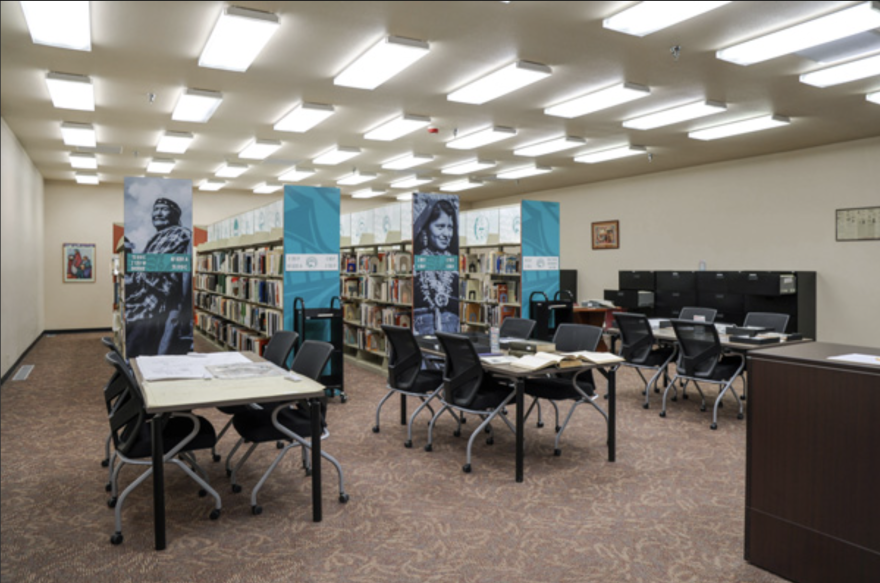In tribal communities, libraries offer many important services for residents. They’re funded by the Indian Education Act, or IEA, and grants, but they often don’t know how much money they will get each year. Mo Charnot with the Santa Fe Reporter recently reported how some lawmakers are looking to change that. They spoke with KUNM about that and the many roles libraries play in tribal communities.
MO CHARNOT: They obviously perform the same services that most librarians typically have, but in much smaller communities, like Ohkay Owingeh, the thing I noticed was that they very much are kind of like people's go-to for anything. When I was there people would show up and ask, like, ‘hey, I need to borrow some gardening tools and stuff like that’ and like, ‘I need to borrow a sewing machine.’ And they all knew each other. It's something where the whole community tries to pitch in, and it's often also a place where they host local tribal events and stuff like that.
KUNM: Did the Ohkay Owingeh librarian Rexine Calvert mention how important tribal libraries are to the community?
CHARNOT: She was telling me about how a lot of people go there who are homeless, who are dealing with unemployment and go there to fill out like Medicaid and stuff like that because broadband connection is still an issue in a lot of tribal areas, and a lot of people just don't have computers at home and they really rely on this to be to, you know, hope that they can find work that they can keep their Medicaid updated.
KUNM: What are some of the challenges tribal libraries face?
CHARNOT: With all areas of tribal education it’s funding because a lot of them kind of told me that the problem is that they're never really sure how much they're going to get. And usually they have to depend on grants, and they have to keep track of all of them at once. And with tribal education, specifically, not, you know, specific to libraries. One thing that is notable is that they usually have a very short amount of time in very small departments to get their budgets together and figure out how they're going to spend the money they do know they're getting. Which can be a big difference between say, a local school board where they have people working in an entire financial department that their entire job is putting these things together each year and figuring out how they're spending their money.
KUNM: So how are these current funding systems not working?
CHARNOT: This came up a lot when I was interviewing with Kevin Shendo. He's the tribal education director in Jemez Pueblo and one of the things that really stuck out to me is that he said the problem is that relying on one-year grants and one-time funding each year and finding out this is how much we're going to get in this year, doesn't really allow for them to build on the funds they have to create long-term programs, like it makes it a lot harder for them to be a more independent education system. And Derrick Lente, he was the one who is proposing the Tribal Education Trust Fund, he said that the issue is every year you know they have to go to the legislature with their hands out and saying that we don't want to have to do that, because it kind of creates a system where they don't really have the ability to do much more than ask for money every year rather than build on their own programs and make them a lot stronger for the students.
KUNM: And what is the Tribal Education Trust Fund?
CHARNOT: It would use money from surplus oil and gas revenue in the state to establish a tribal trust fund that it doesn't replace the IEA it goes alongside it, which would basically put money directly into tribal education departments and allow for them to draw from it to kind of create a much stronger education system, more strongly funded, because when you're relying on one-year grants, it's really hard for them to retain the same staff and work on language programs and things like that.
KUNM: Can you explain a little bit more about the Tribal Remedy Framework?
CHARNOT: So the Tribal Remedy Framework was developed by the Tribal Education Alliance, in response to the Yazzie/Martinez lawsuit that ruled in 2018 that students were not receiving equitable education in New Mexico, particularly Hispanic, disabled, and Indigenous students. And so the response actually has the Tribal Education Trust Fund embedded in it, where it's saying, this is something that would really improve Native education specifically, because of how it would change funding, it would allow for them to have more strongly developed programs. Basically, it's to give tribal education departments more of an ability to be independent, and really get the results that they want from the students.
KUNM: How are Indigenous students being affected by all of this?
CHARNOT: Indigenous students in New Mexico often score really low on assessments. And this often results in poor life outcomes for them, because a lot of them aren't really getting the education that they need, that's culturally relevant to them, that they feel – if tribal education departments were given more sovereignty – they would be able to do and they would be able to make sure that these students leave school ready for the workforce, ready to go to college, ready to do what they want to do.
Support for this coverage comes from the Thornburg Foundation and KUNM listeners.





